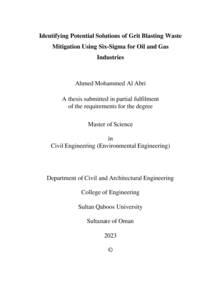Document
Identifying potential solutions of grit blasting waste mitigation using six-sigma for oil and gas industries.
Publisher
Sultan Qaboos University.
Gregorian
2023
Language
English
Subject
English abstract
The oil and gas industry generates a lot of solid, liquid, and gaseous waste, which
harms the environment. Oil and gas companies adapted number of waste
management techniques to reduce the environmental impacts of generated waste and
reduce the associated management cost. Spent blasts (abrasive material) is one of the
big volumes generated waste from oil and gas industry which need attention through
proper handling, storage, and disposal. Grit blast is one of the abrasive types used in
blasting activity. Grit blasting processes produce Grit Blasting Waste (GBW) that is
contaminated with various impurities, including paint, rust, and heavy metals. If such
pollutants are not properly managed, they pose a risk to the environment. Most of the
explored options to improve GBW management are not looking into the root causes
of high generation rates of GBW. It is mainly looking into recycling options after the
generation of waste. There are many techniques to explore the root causes of this
high generation rate, using process improvement and problem-solving tools.
This research focuses on exploring the possible sustainable solutions for the poor
management of grit blasting waste, utilizing six sigma process improvement and
problem-solving methodology. The study investigated the five phases of six sigma
process improvement methodology, i.e., define, measure, analyse, improve, and
control for the oil and gas company.
The research was conducted through following steps: (1) define and measure the
current condition of Grit blasting waste management, (2) analyse the collected data,
(3) identify the root causes of poor management, and (4) develop the possible
sustainable solutions to improve Grit blasting waste management in oil and gas
sector. At define phase, the GBW management defined goal statement and project
timeline. The research measured the size, scope, and level of the problem through
data collection of generated GBW afterward. It showed that the annual GBW
generation rate is increasing and accumulating in GBW storage facilities without
sustainable management. Different analysis tools (graphical and statistical) identified
the root causes of poor GBW management. The causes are - (1) difficulty in blasting
material selection: some of the wastes are not reusable, (2) different contractors
following different standards for blasting activities resulted in different quantities of
GBW, and (3) the number of reuse times of spent GB material in each location is
different. The proposed sustainable solutions for better GBW management could be
short and long-term. (1) Reusing the spent blast in blasting activities and exploring
the feasibility of reselling the GBW to the supplier can be the short-term solution. (2)
Exploring new technologies to generate less GBW and to find recycling options can
be the long-term solution.
Member of
Resource URL
Arabic abstract
تنتج صناعة النفط والغاز كميات كبيرة من النفايات بأشكال مختلفة ، سائلة وغازية وصلبة، مما قد يكون له تأثير سلبي على البيئة، تقوم شركات النفط والغاز باستخدام عدد من تقنيات إدارة النفايات لتقليل الآثار البيئية للنفايات المتولدة وتقليل تكلفة الأدارة المرتبطة بها، تعتبر المواد الكاشطة المستخدمة blast spent( (materials واحدة من النفايات الناتجة بكميات الكبيرة من صناعة النفط والغاز والتي تحتاج إلى مزيد من الأهتمام من خلال النقل والتخزين والتخلص المستدام، حبيبات المواد الكاشطة هي أحد أنواع المواد الكاشطة المستخدمة في أعمال الكشط. حيث إن أعمال أنشطة الكشط بهذه الحبيبات تنتج عنها حبيبات النفايات (GBW( الملوثة بشوائب مختلفة مثل الطلاء والصدأ والمعادن الثقيلة، والتي تشكل خط ا على البيئة إذا لم يتم إدارتها بشكل صحيح. معظم الخيارات التي تم استكشافها لتحسين إدارة GBW ال تبحث في الأسباب الجذرية لمعدلات الأنتاج العالية من هذه المخلفات وإنما تبحث بشكل أساسي عن خيارات الأدارة بعد توليد النفايات مثل خيارات إعادة التدوير، هناك العديد من التقنيات التي يمكن استخدامها لاستكشاف الأسباب الجذرية المحتملة لمعدل الأنتاج المرتفع لهذه المخلفات باستخدام أدوات تحسين العمليات وحل المشكلات. يركز هذا البحث على استكشاف الحلول المستدامة الممكنة لتطوير إدارة مخلفات الحبيبات الكاشطة GBW باستخدام منهجية ستة سيجما (sigma six (والتي تستخدم لتحسين العمليات وحل المشكلات. يتبع هذا البحث المراحل الخمس لمنهجية تحسين العمليات ستة سيجما : التحديد(Define (والقياس(Measure( والتحليل (Analyse (والتحسين (Improve (والتحكم(Control (. قطاع النفط والغاز هو سياق هذه الدراسة. تم إجراء البحث من خلال الخطوات التالية: )1( تحديد وقياس الحالة الحالية لإدارة مخلفات الحبيبات الكاشطة GBW،( 2 )تحليل البيانات التي تم جمعها بشأن هذه النفايات، )3( تحديد الأسباب الجذرية لسوء الأدارة، و )4( إيجاد الحلول المستدامة لتحسين إدارة مخلفات الحبيبات الكاشطة في قطاع النفط والغاز. مرحلة التحديد: تم تحديد مشكلة إدارة GBW، ووضع الهدف والجدول الزمني للمشروع. بعد ذلك ، قاس البحث حجم المشكلة ونطاقها ومدى سوئها، من خلال جمع بيانات GBW المتولدة. وظهر أن معدل التوليد السنوي لهذه المخلفات يتزايد سنويًا، ويتراكم تخزين هذه المخلفات في مرافق إدارة المخلفات بشركات النفط والغاز دون أي حلول مستدامة. تم اتباع أنواع مختلفة من أدوات التحليل )الرسومية والأحصائية( لتحديد الأسباب الجذرية لسوء إدارة GBWوالتي أظهرت الأسباب التالية: )1( اختيار نوع مادة الكشط: بعض المواد غير مجدية إلعادة استخدامها عدة مرات ، )2( مقاولون مختلفون يتبعون معايير مختلفة لأنشطة الكشط والتي أنتجت كميات مختلفة من GBW،( 3 )كذلك يختلف عدد مرات إعادة استخدام المواد الكاشطة المستخدمة في كل موقع. البحث استكشف الحلول المستدامة المحتملة على المدى القصير والطويل لتحسين إدارة GBW في قطاع النفط والغاز: )1( الحل السريع قصير المدى الذي تم اختياره هو إعادة استخدام حبيبات المواد الكاشطة المستهلكة أكثر من مرة في أنشطة الكشط ، وكذلك استكشاف جدوى إعادة بيعها للموردين، )2( الحلول طويلة الأجل هي استكشاف استخدام التقنيات الجديدة وخيارات إعادة التدوير التي تولد كميات أقل من النفايات.
Category
Theses and Dissertations

